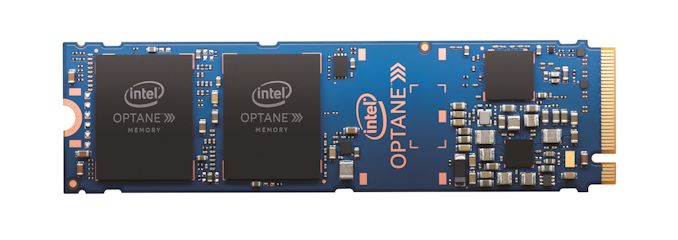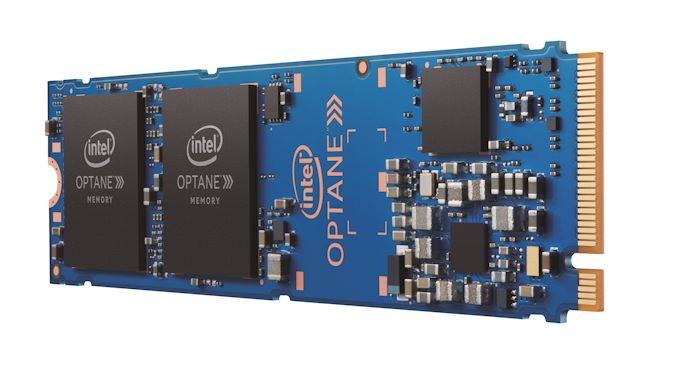Intel Announces Optane Memory M15: 3D XPoint On M.2 PCIe 3.0 x4
by Billy Tallis on May 29, 2019 9:30 AM EST- Posted in
- SSDs
- Storage
- Intel
- Trade Shows
- NVMe
- 3D XPoint
- Optane
- Optane Memory
- Computex 2019

The first major hardware update to Intel's consumer Optane M.2 drives is coming soon, with the Optane Memory M15 drive intended for caching use. Compared to the original Optane Memory and the Optane Memory M10, the M15 updates the controller to widen the PCIe link from two lanes to four lanes, enabling significant performance increases. The maximum throughput will still be lower than what high-end NAND flash based SSDs can achieve at high queue depths, but the Optane Memory M15 doesn't sacrifice any of its unbeatable latency at low queue depths in order to increase throughput compared to its predecessors.
Earlier leaks had indicated that the M15 (codenamed Carson Beach) would add a 128GB capacity, but so far Intel is only announcing the same three capacities offered by the Optane Memory M10: 16GB, 32GB and 64GB. The Optane M10's hardware is also sold as the Optane SSD 800P, and that product line does include a 128GB/118GB model. The upcoming Optane SSD 815P that will similarly share a hardware platform with the Optane Memory M15 is expected to continue offering both 58GB and 118GB usable capacities.
| Intel Optane Memory Specifications | ||
| Model | Optane Memory M15 | Optane Memory M10 |
| Form Factor | M.2 2280 M key | M.2 2280 B+M key |
| Interface | PCIe 3.0 x4 | PCIe 3.0 x2 |
| Protocol | NVMe 1.1 | NVMe 1.1 |
| Capacities | 16 GB, 32 GB, 64 GB | 16 GB, 32 GB, 64 GB |
| Memory | 128Gb 20nm Intel 3D XPoint | 128Gb 20nm Intel 3D XPoint |
| Sequential Read | up to 2000 MB/s | up to 1450 MB/s |
| Sequential Write | up to 900 MB/s | up to 640 MB/s |
| Random Read (QD4) | up to 450k IOPS | up to 250k IOPS |
| Random Write (QD4) | up to 220k IOPS | up to 140k IOPS |
| Read Latency (QD1) | 6.75 µs | 6.75 µs |
| Write Latency (QD1) | 12 µs | 18µs |
| Max Active Power | 5.5 W | 3.5 W |
| Idle Power | <5 mW | 11 mW |
| Endurance | 365 TB | 365 TB |
| Warranty | 5 years | 5 years |
| Launch Date | ~July 2019 | March 2018 |
Doubling the width of the PCIe interface doesn't provide a doubling of any of the performance metrics Intel specifies for the M15, but random read throughput does increase by 80%. Maximum power draw has increased from 3.5 W to 5.5 W, but idle power has been cut in half and should now be competitive with most flash-based NVMe SSDs.
Intel's PR photos of the Optane Memory M15 show very little change to the layout of the board, and in particular the controller doesn't seem to be any larger than the original PCIe x2 version. Adding two more PCIe lanes without increasing the controller package size isn't too hard, but given how small the controller still is, we're pretty sure that the interface between the controller and the 3D XPoint media isn't any wider.
Officially, the Optane Memory M15 still requires a Kaby Lake or newer platform, so it has broader compatibility than the Optane Memory H10 that requires a Coffee Lake or newer system to support its two drives on one card design. The driver requirement has been bumped from Intel RST version 15.7 or newer up to RST version 17 or newer. However, the processor and driver requirements only apply to using Intel's Optane Memory caching software for Windows; without it the M15 is another standard M.2 NVMe SSD that's unusually small and fast compared to flash-based NVMe SSDs.
The Optane Memory M15 will be available for purchase starting around the middle of Q3, so we're hoping to receive a review sample within a month or so. Pricing has not yet been announced. Leaked roadmaps showed that Intel had previously planned to launch the M15, the Optane Memory H10 and the still unofficial Optane SSD 815P all at the beginning of 2019. The H10 was officially launched in April and is now available as an OEM-only part in some new notebooks.
| Want to keep up to date with all of our Computex 2019 Coverage? | ||||||
 Laptops |
 Hardware |
 Chips |
||||
| Follow AnandTech's breaking news here! | ||||||











9 Comments
View All Comments
Chaitanya - Wednesday, May 29, 2019 - link
Meh is an understatement when it comes to these M15 and M10.ArizonaSteve - Wednesday, May 29, 2019 - link
Meh is an understatement when it comes to Intel in general.shabby - Wednesday, May 29, 2019 - link
Go home intel you're drunk with those paltry sizes.Billy Tallis - Wednesday, May 29, 2019 - link
They're reasonable sizes for caches, though SSD caching doesn't have much appeal these days since TLC drives are so cheap. I'm hoping that they decide to go beyond 128GB for the 815P, but I expect we'll be disappointed.wumpus - Thursday, May 30, 2019 - link
I'd assume that you want to cache your T[or Q]LC drive, although it isn't clear that the overhead will be worth it. A more plausible choice would be as a swap drive for large (probably numerical) computation, when >32GB isn't enough but more gets really expensive (especially the motherboard [DDR3 + used server may also work well]).On the other hand, most 1TB T[Q]LC SSDs have at least 64GB pseudo-SLC, so it makes it pretty hard to justify either.
msabercr - Thursday, June 6, 2019 - link
I think you're looking for the 905P 380GB m.2 221105080 - Wednesday, May 29, 2019 - link
Where is Intel's M.2 PCIe 4.0 Optane Memory for AMD's X570 chipset?Casper42 - Wednesday, May 29, 2019 - link
They have Bigger fish to fry...https://www.anandtech.com/show/14183/intel-to-alig...
Skeptical123 - Wednesday, May 29, 2019 - link
"Adding two more PCIe lanes without increasing the controller package size isn't too hard," Also this is just a (kinda) educated guess but I bet there is a decent chance the controller package already was designed around 2 or 4 lines originally. So things like pins for 2 additional PCIe lanes and such already existed on current 2 lane M10 controller's.